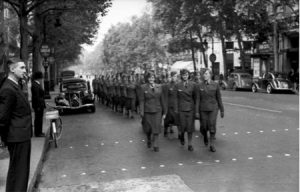Wehrmachthelferinnen (Female Auxiliaries) of the German Wehrmacht (1939-1945)
“The femininity of the female Wehrmacht auxiliaries was to be preserved at all costs.” – Adolf Hitler
The Wehrmachthelferinnen were female auxiliaries of the German Wehrmacht, the unified armed forces of Nazi Germany from 1935 to 1946. Germany employed women in auxiliaries in World War I as well, but the devastation of World War II transformed the roles of women in military. Much like other belligerent nations during World War II, Germany mobilized its women for the war effort. Yet, Germany was at the beginning of the war more reluctant to do so than other countries like Britain, fearing that it would destroy the morale of both civilians and soldiers. But soon the needs of “total war” changed Nazi policy, single and married women of the lower classes, were not only mobilized to replace an increasing number of conscripted men in the war economy, but more and more also in the Wehrmacht itself. At the end of the war every twentieth soldier in the Wehrmacht was a woman, even though they were not named as such.
During World War I, Germany had deployed women as nurses, rear area auxiliaries, and message helpers. However, the extent of the service of women in the Wehrmacht in World War II was much more significant. According to historian Karen Hagemann, “By the end of the war the total number of women in the Wehrmacht had risen to more than 500,000, 160,000 of whom served as Flak gun auxiliaries (Flakwaffenhelferinnen) in the antiaircraft defense organized by the air force.” Women served in the Wehrmacht in a number of different auxiliaries like the reserve army as signal auxiliaries with the field army, the air force, and the navy.
According to Hagemann, “Most of the volunteer Wehrmacht auxiliaries had been members of the League of German Girls (BDM), the female branch of the Hitler Youth, which strongly encouraged girls to enlist for military service.” The BDM girls aligned themselves with Nazi ideology and were willing to support their the state and its military in anyway necessary, which led to thousands of young and single women volunteering for military service. However, they did so with an understanding that they were only “helpers” of them men, not soldiers. Women in the auxiliaries were not given military status and according to Allen, these women were requested “to remain feminine and never to become rough warriors.” The emphasis on the femininity of the Wehrmachthelferinnen was very important because of the belief that the deployment of women in the military would damage the morale of both soldiers and civilians.
The mobilization of women in the Wehrmacht occurred in four different phases. Beginning in the 1939 and 1940, the female Wehrmacht auxiliaries were deployed outside of Germany to occupied countries. In this first wave of female auxiliaries, these women were employed in such areas as the telephone and telegraph offices, the air-raid warning service, and the air reporting service. In order to serve in the military, women had to be at least twenty-one years old. Only women who volunteered were accepted, which led to a publicity campaign during the second phase of the deployment of women auxiliaries in 1941. As the war progressed, the Nazi Party promoted voluntary female military service to replace men from communications and clerical areas so they could be deployed to the front lines. The next two phases of the deployment of women saw the female auxiliaries occupying positions with more responsibility and closer to the frontlines.
At the end of 1942 and into early 1943, the third stage of the deployment began. Women would now be required to operate command and control equipment like the air force’s Flak units. These Flak units were a part of the antiaircraft defense and were originally operated only by women who volunteered. However, as World War II causalities rose, more and more women were subjected to operating in antiaircraft defense units. In 1944 the fourth phrase of deployment, known as Endkampf (final struggle), used women to replace soldiers in the air force to free up able-bodied men for other positions. After this decree the majority of the military air defense consisted of young girls, old men and Hitler Youth boys by the end of World War II.
The female auxiliaries of the Wehrmacht, similar to other female auxiliaries of the belligerent nations, were negatively received by the societies they served because, by serving in the military, they challenged societal gender norms. According to Allen, “the public expressed its distaste for female soldiers by giving them the condescending name of “lightning girls” (Blitzmädchen).” The Wehrmachthelferinnen were young, single girls. The female auxiliaries were often denounced and referred to as “officer’s mattress’ or “soldier’s floozy,” which served to devalue the contributions of the female auxiliaries of the Wehrmacht.
As historians, we must discuss the Wehrmachthelferinnen of the German Wehrmacht to understand one of the ways in which women supported the Third Reich during World War II. The female auxiliaries were an integral part of the German armed services. However, these women also faced harsh criticism for upsetting German morale and societal norms during a time of devastation. The harsh reception towards the female auxiliaries in Germany is another example of a patriarchal society reluctant to adjust gender norms, while at the same time benefitting from women’s labor in traditionally ‘masculine’ roles. After the war, the service of the Wehrmachthelferinnen and their problematic role of helping to prolonged the Nazi warfare and Holocaust, was long forgotten and suppressed in Germany.
Kayla Travis, Exercise and Sport Science major and History minor, Class of 2018
Sources
Literature and Websites
- Allen, Ann T. Women in Twentieth-Century Europe, 60-70 and 79-96. Basingstoke and New York: Palgrave Macmillan, 2007.
- Hagemann, Karen. “Mobilizing Women for War: The History, Historiography, and Memory of German Women’s War Service in the Two World Wars.” Journal of Military History 75, no. 3 (2011): 1055-1093.
Images




